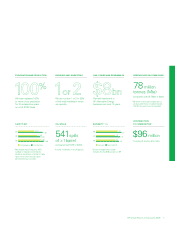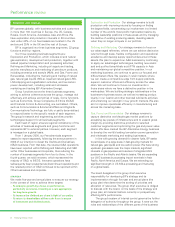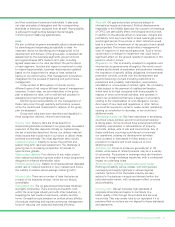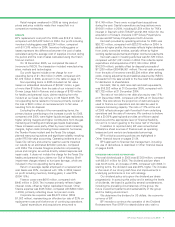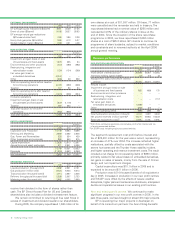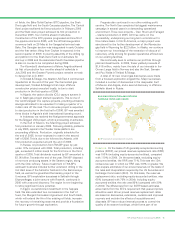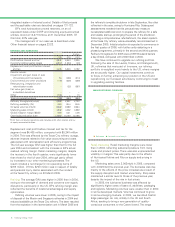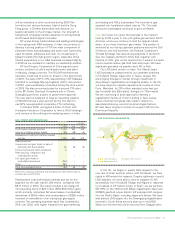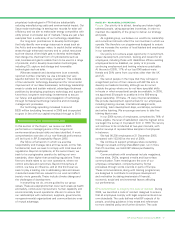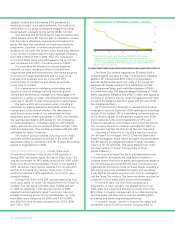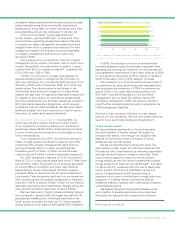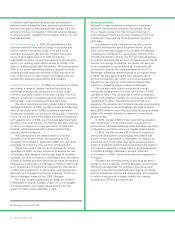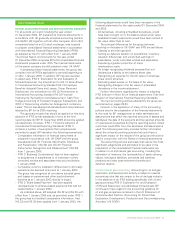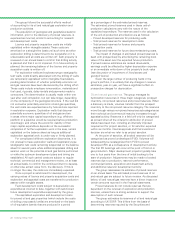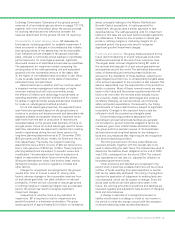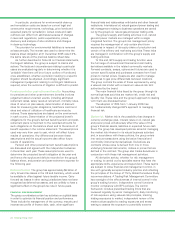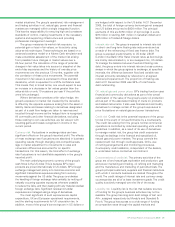BP 2005 Annual Report Download - page 19
Download and view the complete annual report
Please find page 19 of the 2005 BP annual report below. You can navigate through the pages in the report by either clicking on the pages listed below, or by using the keyword search tool below to find specific information within the annual report.
BP Annual Report and Accounts 2005 17
INSIDE BP – RESPONSIBLE OPERATIONS
People Our priority is to attract, develop and retain highly
talented people, using appropriate incentives, in order to
maintain the capability of the group to deliver our strategy
and plans.
As a global group, we believe our workforce, leadership
and recruitment should reflect the communities in which we
operate. We therefore run programmes designed to ensure
that we increase the number of local leaders and employees
in our operations.
Our policy is to ensure equal opportunity in recruitment,
career development, promotion, training and reward for all
employees, including those with disabilities. Where existing
employees become disabled, our policy is to provide
continuing employment and training wherever practicable.
At the end of 2005, 17% of our top 606 leaders were
female and 20% came from countries other than the UK
and US.
We recruit people in the hope that they will spend
a significant portion of their careers with BP. We aim to
develop our leaders internally, although we do recruit
outside the group where we do not have specialist skills
in-house or when exceptional people are available. In 2005,
we appointed 89 people to positions in the 606-strong
group leadership. Of these, 72 were internal candidates.
We provide development opportunities for our employees,
including training courses, international assignments,
mentoring, team development days, workshops, seminars
and online learning. We encourage everyone to take five
training days a year.
In our 2004 survey of employees, completed by 74% of
those eligible, the level of satisfaction was the highest since
we began the survey in its present form in 1999. The survey
will continue to be conducted at two-year intervals, with
shorter surveys of representative samples of employees
in between.
We had 96,200 employees at 31 December 2005,
compared with 102,900 at the end of 2004.
We continue to support employee share ownership.
Through our award-winning ShareMatch plan, run in more
than 70 countries, we match BP shares purchased by
employees.
Communications with employees include magazines,
intranet sites, DVDs, targeted e-mails and face-to-face
communication. Team meetings are the core of our
employee consultation, complemented by formal
processes through works councils in parts of Europe.
These communications, along with training programmes,
are designed to contribute to employee development
and motivation by raising awareness of financial,
economic, social and environmental factors affecting
our performance.
BP’s commitment to integrity: the code of conduct During
2005, we launched a code of conduct designed to ensure
that all employees comply with legal requirements and our
own standards. The code defines what BP expects of its
people, providing guidance in key areas and references
to more detailed policy and further direction. The code
proprietary technologies in PTA that are substantially
reducing manufacturing costs and environmental impact. Our
Saturn solar technology is setting new records for solar cell
efficiency and we aim to make solar energy competitive with
utility power in a broader set of markets. These are just a few
examples from a wide array of our technology capabilities.
Our long-term priorities are to develop technologies
that help identify new energy resources in areas such as
the Arctic and ever-deeper water, to exploit better existing
areas through enhanced recovery and to unlock resources
such as viscous oil and tight gas; to develop technologies
that change the chemical form of hydrocarbons such as
coal, biomass and gas to enable them to be used in a range
of products; and to develop lower-carbon technologies,
including CO2capture and storage and renewable
technologies such as solar.
Whereas research and development is an externally
reported number, internally we use a broader but very
specific definition for technology investment. This consists
of four elements: technology development for incremental
improvement of our base businesses; technology leadership
areas to create and sustain material, advantaged business
positions by developing proprietary technology and superior
know-how; long-term technology investments to secure
our future; and application and propagation of technology
through formalized technology networks and knowledge
management processes.
Our technology spending increased to around
$825 million (excluding Innovene) in 2005 and is expected
to grow in line with our capital employed through to 2010.
Environmental and social performance
In this section of the Report, we review our 2005
performance in managing some of the longer-term
environmental and social risks we have identified. A more
comprehensive overview of our non-financial performance
will be found in BP Sustainability Report 2005.
We follow a framework in which we exercise
responsibility and manage risks at three levels. At the first,
fundamental, level we seek to comply with local laws and
regulations. Beyond compliance, at the second level, we
seek to be a progressive operator by setting our own
standards, often higher than prevailing regulations. These
first two levels relate to our own operations, where we
control activities and outcomes. Beyond this sphere of
control, we have an influence, and at this third level we
seek to play a leading role in addressing risks and issues
in selected areas that are relevant to our work and affect
society more generally. These include climate change and
the challenges of development.
In everything we do, we are guided by our group
values. These are aspirations that cover such areas as health
and safety, continuous improvement, human capability and
environmentally sound operations. We aim to ensure that
our relationships with customers, suppliers, governments,
non-governmental organizations and communities are ones
of mutual advantage.


